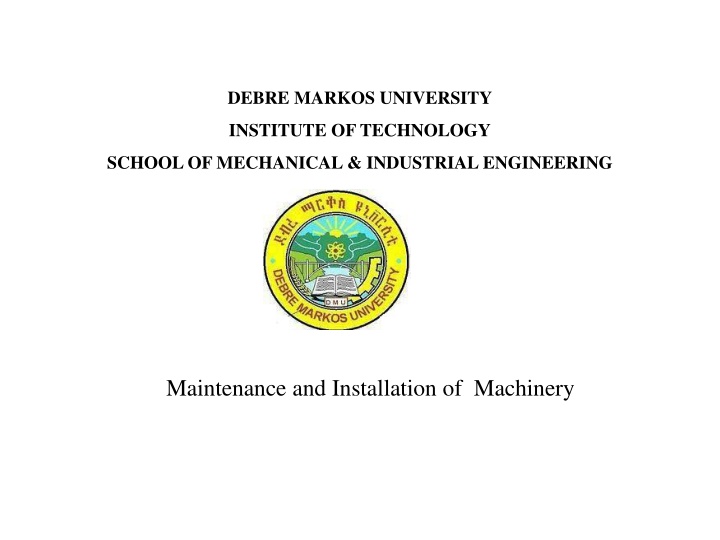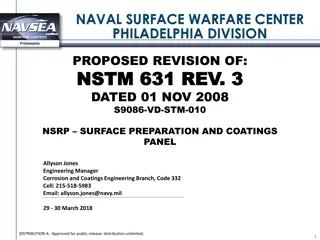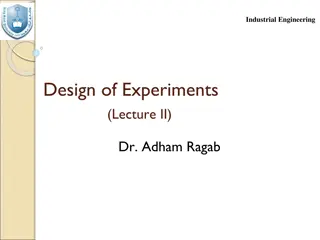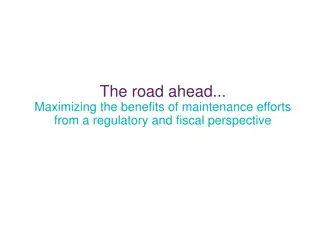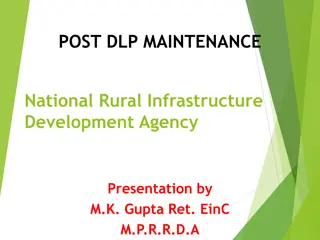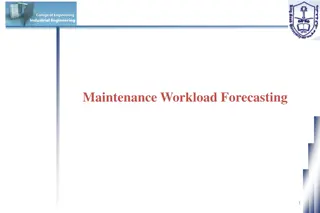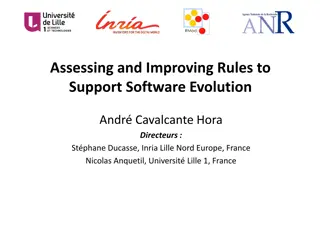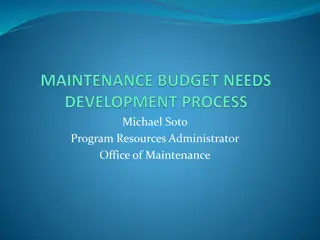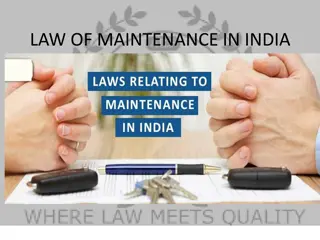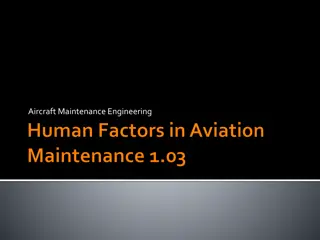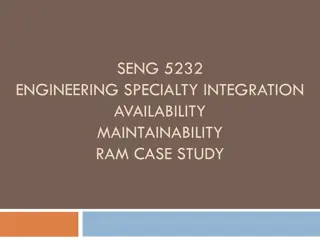Evolution of Maintenance Practices in Industrial Engineering
Explore the historical progression of maintenance practices from the pre-World War II era to modern times, highlighting the shift from reactive to preventive maintenance strategies. Discover how maintenance activities are vital for ensuring optimal operational conditions of machinery and facilities, ultimately contributing to industry success.
Download Presentation

Please find below an Image/Link to download the presentation.
The content on the website is provided AS IS for your information and personal use only. It may not be sold, licensed, or shared on other websites without obtaining consent from the author.If you encounter any issues during the download, it is possible that the publisher has removed the file from their server.
You are allowed to download the files provided on this website for personal or commercial use, subject to the condition that they are used lawfully. All files are the property of their respective owners.
The content on the website is provided AS IS for your information and personal use only. It may not be sold, licensed, or shared on other websites without obtaining consent from the author.
E N D
Presentation Transcript
DEBRE MARKOS UNIVERSITY INSTITUTE OF TECHNOLOGY SCHOOL OF MECHANICAL & INDUSTRIAL ENGINEERING Maintenance and Installation of Machinery
Chapter one Introduction to maintenance and Installation of machinery History of maintenance First generation In the period of pre-World War II, people thought of maintenance as an added cost to the plant which did not increase the value of finished product. Therefore, the maintenance at that era was restricted to fixing the unit when it breaks because it was the cheapest alternative 1
Second Generation During and after World War II at the time when the advances of engineering and scientific technology developed, people developed other types of maintenance, which were much cheaper such as preventive maintenance. In addition, people in this era classified maintenance as a function of the production system. 2
Third Generation Nowadays, increased awareness of such issues as environment safety, quality of product and services makes maintenance one of the most important functions that contribute to the success of the industry. World-class companies are in continuous need of a very well organized maintenance programmed to compete world-wide. 3
1.1 Maintenance definition? Maintenance: Keeping something in good condition by checking or repairing it regularly , Maintenance consists of those activities required to keep a facility in original (i.e. as-built) condition so that its designed productive (or performance) capacity remains unchanged. Maintenance can be defined as a combination of actions carried out to repair, replace or service the components with an aim to bring the servicing unit to original (or as original) condition so that it can operate designed capacity for a specified period of time. 4
Con.. Maintenance is a set of organized activities that are carried out in order to keep an item in its best operational condition with minimum cost acquired. Maintenance Activities Activities of maintenance function could be either repair or replacement activities, Maintenance activities are necessary for an item to reach its acceptable productivity condition and these activities, It should be carried out with a minimum possible cost. 5 9/26/2024
In other words, maintenance can also be defined as follows Maintenance is the totality of all measures directed towards control (preservation and restoration) of the performance of a plant. It is an auxiliary process in a production process directed towards a high effectiveness of the main process. 6
1.2 Trends in the Evolution of Maintenance According to John Moubray , author of Reliability Center Maintenance, the evolution of maintenance since the 1930 s can be traced through three generations. The distinction between these generations depends up on basically three technical factors: Growing expectations of maintenance, Changing view on equipment failures, and Changing maintenance techniques 7
1.3 Maintenance Objectives Maintenance objectives should be consistent with and subordinate to production goals. The relation between maintenance objectives and production goals is reflected in the action of keeping production machines and facilities in the best possible condition. 10
Basic Maintenance Objectives Improving equipment efficiency and reducing scrap rate. Minimizing energy usage. Optimizing the useful life of equipment. Reducing downtime. Providing reliable cost and budgetary control. Identifying and implementing cost reductions. 11
1.4 Types of Maintenance Different authors categorize maintenance in variety forms. The most acceptable ones is Planned maintenance Unplanned maintenance 13
TYPES OF MAINTENANCE Maintenance Unplanned Maintenance Planned Maintenance or Scheduled Maintenance or Systematic Maintenance or Routine Maintenance Corrective Maintenance Preventive Maintenance Runnin g Maint. Predictive Maint. Shutdown Maint. Design Out Maint. Shutdown Maint. Breakdown Maint. Emergency Maint. 14
1. PLANNED OR SCHEDULED MAINTENANCE It is basically done for two purposes: To prevent the occurrence of breakdown and, If breakdown has occurred then to restore it to original condition 15
A. Preventive Maintenance Principle Prevention is better than cure Procedure - Stitch-in-time It is done to keep an equipment or machinery in a satisfactory operating condition through regular inspection, calibration, lubrication, overhauling, or replacement of certain components. It is action before breakdown occurs. 16
Cont.. Preventive Maintenance It is a set of activities that are performed on plant equipment, machinery, and systems before the occurrence of a failure in order to protect them and to prevent or eliminate any degradation in their operating conditions. the maintenance carried out at predetermined intervals or according to prescribed criteria and intended to reduce the probability of failure or the degradation of the functioning and the effects limited. Its activities include adjustments, major overhauls, inspections and lubrications. 17
Con The factors that affect the efficiency of PM of maintenance 1.The need for an adequate number of staff in the maintenance department in order to perform this type of maintenance, 2. The right choice of production equipment and machinery that is suitable for the working environment and that can tolerate the workload of this environment, 3. The required staff qualifications and skills, which can be gained through training, 4. The support and commitment from executive management to the PM program, 5. The proper planning and scheduling of PM program, and 6. The ability to properly apply the PM program. 18
Advantages Of Preventive Maintenance Reduction in downtime, Reduction in loss of production, Reduction in repair and replacement cost, Fewer stand-by equipment required, Less expenditure on maintenance personnel due to over time, Fewer parts to be stored, Higher safety level in the shop, and Planned output possible to maintain. 19
Preventive Maintenance is divided into four categories 1.Running Maintenance is done even when the machine or equipment is in service. 2.Shut-down Maintenance which is a set of preventive maintenance activities that are carried out. When the production line is in total stoppage situation 3.Design-out Maintenance Equipments are designed that no maintenance should be required or at worst least maintenance should be done. 4.Predictive Maintenance is done on the information received regarding the performance of an equipment or machinery. 20
Predictive Maintenance (PDM) PDM is classified into two kinds according to the methods of detecting the signs of failure: 1, Condition-based predictive maintenance, and 2, Statistical-based predictive maintenance. Condition-based predictive maintenance depends on continuous or periodic condition monitoring equipment to detect the signs of failure. Statistical-based predictive maintenance depends on statistical data from the meticulous recording of the stoppages of the in-plant items and components in order to develop models for predicting failures. 21
B. Corrective Maintenance On this type, actions such as repair, replacement, or restore will be carried out after the occurrence of failure in order to eliminate the source of this failure or reduce the frequency of its occurrence corrective maintenance:- is done to bring the machinery to original performance level, by minor adjustments of certain knobs, or key units or replacing some worn-out parts. This could be Complete failure Minor failure 22
Corrective Maintenance Could be: 1.Deferred CM , 2.Shutdown CM. Deferred maintenance: which is a set of corrective maintenance activities that are not immediately initiated after the occurrence of a failure but are delayed in such a way that will not affect the production process Shutdown corrective maintenance, which is a set of corrective maintenance activities that are performed when the production line is total stoppage situation. 23
TYPICAL CAUSES OF EQUIPMENT BREAKDOWN Lack of lubrication Failure of cooling system Failure to replace worn-out parts Negligence to rectify minor faults Too high or too low voltage supply Wrong fuels used Uneven working parameters Unsound foundation, etc. 24
Disadvantages of Corrective Maintenance Breakdown generally occurs inappropriate times leading to poor and hurried maintenance Excessive delay in production & reduces output Faster plant deterioration Increases chances of accidents and less safety for both workers and machines More spoilt or failed materials Direct loss of profit Can not be employed for equipment regulated by statutory provisions e.g. cranes, lift and hoists etc. 25
Maintenance Costs Cost Total Maintenance Cost PM Cost Breakdown Cost Maintenance Commitment Optimal 26
1.5 Introduction to Machine Installation Machine: It is a device that takes some energy as input and transforms it to another useful form of energy as output. Machine Installation: It is the process of fixing and erecting the machinery in an industry so that they can be put to use for productive purposes 27
Why Machine installation is necessary? It is the first step in the productive process of any newly established plant. Where to install machinery? The installation of light machinery used for domestic use may not require any expertise, where as the installation of the machinery used in the industry need attention as the performance of the machinery largely depend upon proper installation. How to install machinery? The installation process may differ from machine to machine and it is largely depend upon the main specifications of the machines to be installed. 28
Factors to be considered before installing the machinery It is important that as much information as possible be supplied regarding the machine to be installed, this will include: Machine size and weights Any dynamic features of its operation Location including ground type, condition where optimal performance is required Vibration analysis of the machine Site conditions 29
FOUNDATION REQUIREMENTS A. Building Foundations Footings and foundations as having two functions: 1. To transfer the live and dead loads of the building to the soil over a large enough area so that neither the soil nor the building will move 2. In areas where frost occurs, to prevent frost from moving the building Dead loads are the weight of the building materials and the soil surrounding the foundations. Live loads include the weight of people, furniture, snow, rain, and wind. 30
B. Machine Foundations The main purpose of machine foundations is to stabilize the machine as well as to reduce the vibrations caused due to the operation of the machine. The foundation thus positively influences machine vibration by reducing the amplitude of oscillation. The first step in machine installation is to find out whether it is required to build a special foundation for installation or it is possible to use the existing floor. 31
Foundation Requirements for machine installation If the existing floor, where the machinery is to be installed, does not meet the following minimum requirements, It is required to build a foundation. The area of the floor where the machine frame is to be located must be a single, homogeneous slab in good condition. The floor must be 4" to 6" thick (It is not a constant and may change depending upon the type and weight of machinery). The floor must be capable of supporting 3.5 tons/ft (This is also not a constant one and may subject to change depending upon the type of machine going to be installed and the floor must be level to 0.032"/ft). 32
Methods of machine installation There are two types of machine installations in practice, which include both foundation anchoring and floor installation procedures. The following sections will explain these methods. 1. Foundation Anchoring Procedure Installing the machine using foundation & J-bolt 33
2. Floor anchoring method Installing the machine using existing floor & J-bolt 34
MACHINE LEVELING Proper Machine leveling is critical in the machine installation for the desired machine performance. The term leveling, with respect to machinery installation, means the operation of placing machinery or equipment on a true horizontal plane. The flatness of the floor plays an important step in the levelling procedure of the machine. ALIGNMENT OF SHAFTS Proper shaft alignment is achieved when the two centerlines of coupled machinery are the same or collinear. There are two types of coupling or shaft misalignment: angular misalignment and parallel misalignment 35
Angular misalignment is a condition where two shaft centerlines are at an angle to each other. Parallel misalignment is a condition where no angular misalignment exists and the shafts are parallel, but offset from each other. 36
Four basic steps are required to correct misalignment: 1. Correct for angular misalignment in the side view plane 37
2. Correct for parallel misalignment in the side view plane 38
3. Correct for angular misalignment in the top view plane 39
4. Correct for parallel misalignment in the top view plane 40
Reading assignment Difference between Maintenance and Repair ??? Thank you ! 41
